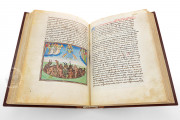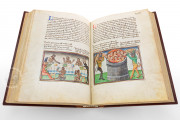The Book of the Vineyard manuscript in the Bodleian Library is the second volume of a vast compendium of medieval Christian beliefs concerning Christ, Antichrist, the Last Judgment, hell, and heaven. Made in southeastern France around 1460, it boasts eighty-three miniatures, many of which picture the torments of hell in vivid and lurid detail. The copious corrections to the text suggest that the author may have been the manuscript's scribe.
The first volume of the Book of the Vineyard discusses the Incarnation, Passion, and Resurrection of Christ. The Bodleian volume treats Antichrist (fols. 1r-53v), the Last Judgment (fols. 53v-79v), the torments of hell (fol. 80r-129v), and heaven or paradise (fols. 129v-165v) preceded by a list of its 164 chapters (fols. ii-iv).
Antichrist
Medieval Christians developed the belief that Antichrist—a human incarnation of evil—would appear before the Last Judgment to deceive Christians. The Book of the Vineyard describes him as "both man and devil." In the manuscript, he is pictured as a well-dressed young man with two heads, one atop the other (fol. 4r). The second head is that of a red, horned devil symbolizing that the devil has entered the body of the fair youth.
Fifteen Days
The manuscript's first section, devoted primarily to Antichrist and his activities, includes a description of the fifteen signs of the coming Judgment, each arriving one day after the next (fols. 41v-49v). This is a densely illustrated portion of the manuscript, with a large miniature for each sign.
The miniatures often elaborate upon the text. For example, the text reports that animals refuse to eat and drink on the fifth day. The painter, however, emphasized the agony of the animals by showing the bear, stag, and lion with lolling tongues, clearly suffering from thirst (fol. 43v).
Punishment to Suit the Sin
Among the many torments of hell described and pictured is a series of specific punishments for those committing each of the seven cardinal or deadly sins. The miniature of the torment of the greedy, pictured to include high-ranking clerics, for example, shows them in cauldrons of boiling metal because they were in life "ablaze" with miserliness (fol. 85r).
Copied by a Carthusian?
The treatise in Middle French incorporates many citations of the Bible and early Christian authors in Latin. It was written in Gothic Hybrida by a single scribe, who may have been a monk of the Grande Chartreuse, the mother house of the Carthusian order of monks.
Although the text may have been composed and written out in a monastic context, the manuscript's illumination is unquestionably the work of several professional painters, including one of exceptional talent who painted three miniatures of the celestial court with Christ or the Virgin at the center (fols. 144v-145r, 151r, and 152r), all with brilliant blue backgrounds.
Contemplating the End of Time
The book was probably intended for reading and viewing by a layperson, who would have approached its imagery as a focus of devotion. "Dominus Johannes Blathe" (or Blache) has been scratched into the leather of the front cover, perhaps an early owner of the book.
In the eighteenth century, the manuscript was owned by the French collector Gilbert Paignon-Dijonval (1708-1792). It subsequently passed through the collections of Charles Gilbert Terray (1759-1842), Viscount of Morel de Vindé, and Thomas Frognall Dibdin (1776-1847) before being acquired in 1823 by Francis Douce (1757-1834).
We have 1 facsimile edition of the manuscript "Book of the Vineyard": Il Manoscritto Douce 134. Mirabile Visione facsimile edition, published by Istituto dell'Enciclopedia Italiana - Treccani, 2019
Request Info / Price






















